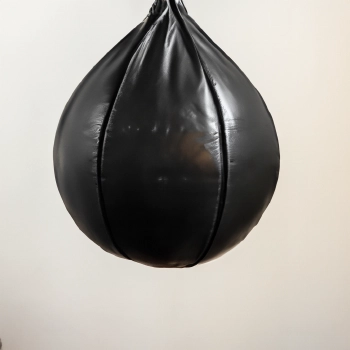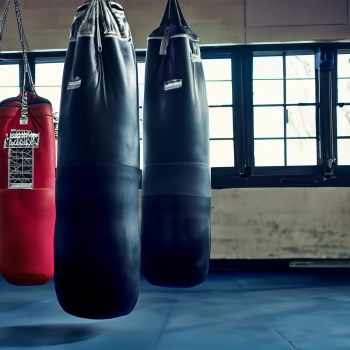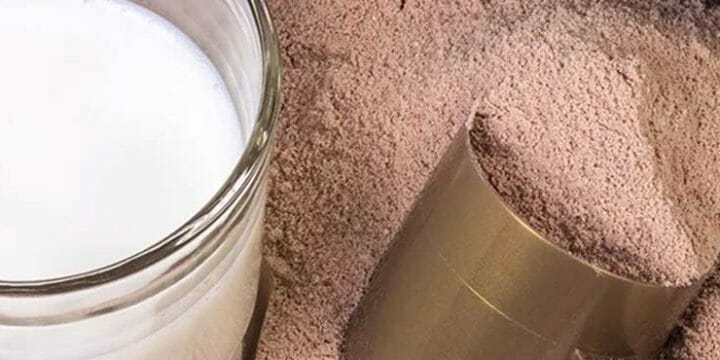On a recent trip to an MMA gym, I saw that the owners had swapped out some traditional boxing bags for water punching bags.
I was intrigued enough to talk to the coaches and a fighter to see how and when they use these water-filled bags.
As it turns out, there’s a right and wrong time to be using them. And Muay Thai, MMA, and boxing gyms have a specific approach that I want to share with you here.
Quick Summary
- Water heavy bags offer better feedback, versatility in shape and size, and easy storage/portability.
- Traditional punching bags provide a heavier weight for power training, better stability, and longer durability.
- Water bags allow you to set up for boxing training without having to transport a 100 lbs sand-based bag.
- In my opinion, the choice between water heavy bags and traditional punching bags should be based on individual training goals, with water bags being great for precision and agility, and sandbags for strength and power.
What Is An Aqua Bag?

An aqua punching bag is a training tool that helps an MMA fighter or boxer to train their punching and kicking skills.
Unlike traditional sandbags, water punching bags are usually made of a strong rubber material that allows them to store large volumes of water.
You’ll also find that these water-filled bags come in many different shapes and sizes that have become particularly suitable for a martial artist to train high-precision kicks.
According to insights from a study published by the National Institutes of Health (NIH), water-heavy bags are useful for practicing dodging and footwork as they are more maneuverable than traditional bags. They can also be used to improve cardiovascular fitness and hand-eye coordination [1].
Benefits Of A Water Punching Bag

My friend Steve is a mixed martial arts coach, and he highlighted a few reasons why the aqua training bag is the preferred training tool for some of the fighting techniques.
1. Bag Design Options
This is the most important advantage of an aqua bag, as you don’t just have the large cylindrical bags available. A much more popular option is the teardrop shape water punching bag, which is ideal for use as uppercut bags.
And if you really want to get an authentic experience, then you can buy aquabags that have the shape of the human upper body.
And here’s why that’s important.
2. Enhanced Safety with Impact Absorption
They are highly effective in reducing the impact of the punch, making them safer than traditional heavy bags filled with foam or sand.
This is because the water absorbs the force of the punch, thereby reducing the risk of injury to the fighter.
3. More Training Methods
Whether you’re a beginner or advanced fighter, a normal heavy bag usually involves the same type of impact over and over.
With water bags, you can approach your training sessions to either work on strength and stamina through repetitive types of punches, or you can switch to high-precision training.
This ability to easily switch between different types of body shots is what allows folks to increase their skill levels.
4. Easy Storage
Another one of the benefits of aqua punching bags is that they are easier to store when not in use.
At a commercial gym, that’s not going to be an issue, but for home use in a garage gym, people will find it easier to empty out a water bag and then pack it away until your next training day.
5. Better Portability
The final benefit to highlight is that water bags allow you to set up for boxing training without having to transport a 100 lbs sand-based bag.
Once you empty out aqua bags, they only weigh a few pounds, and you can flatten them down to bring them to a different training location.
I know it’s not something people would often do, but I know some folks who like that kind of flexibility.
Downsides Of A Water Punching Bag

As indicated by my tests, aqua training bags have some limitations, including the risk of leaks and the need for regular refilling, which can impact their effectiveness in boxing and MMA training.
1. Risk Of Leaks
While aqua punching bags are generally made of very durable materials, it will inevitably happen that it wears down.
Imagine a traditional heavy bag with sand that has received thousands of punches over the years. Eventually, you’ll see that sand trickling out.
With a water bag, that result can become a bit messier, and you’d need to act quickly to avoid a few gallons of water spilling over your gym floor.
2. Regular Refilling
After initially filling a water punching bag, you will need to keep topping it up. The reason is that the water will gradually evaporate, and a deflated water bag will lose all of its benefits.
3. Suitability For A Professional Boxer
Water-filled punching bags are also not always the best option for pro boxers.
This is especially the case when it comes to speed bags for speed training [2]. Even though you can find water punching bags in that shape and size, they simply don’t work well for that purpose.
What Is A Sand Punching Bag?

A sand punching bag is a cylindrical type of boxing bag usually made with an outer layer of leather as a hard-wearing material to avoid it splitting open.
You’ll find these types of heavy bags in every boxing and martial art gym as they are still the ideal training tool for practicing all types of body blows.
You’ll find these either hanging from the ceiling or set up on a bag stand, and both challenge you to practice better foot and body work as well as working on high-intensity and accuracy.
Benefits Of A Sand Punching Bag

To add some balance to this post, I hooked up with a boxing coach to get his input on using heavy bags and why they might be a better option than the aqua punching bags.
He uses both sand and water punching bags but finds that the good old-fashioned boxing bag will remain one of the most common options.
1. Much Heavier Weight
A heavy puncher can create an awful lot of power in strength and cardio workouts on heavy bags.
If you ever get a chance, stand behind a bag and feel the indirect impact of a heavy-weight punch on your body, take it.
You’ll find heavy bags available in sizes that go all the way up to 150+ lbs in all boxing gyms because the heavier the punch, the heavier the bag needs to be.
That’s something you can’t match with a water bag.
2. Better Stability
A boxing bag with heavier weight will not swing around as much and provide more stability. The impact of every punch will transfer the energy and power to the bag, and the harder you punch, the more the bag will move.
What can happen then is that you need to stop your workout and stop the swinging bag so that you can start over again.
That’s not just annoying but also disruptive.
3. Longer Lasting
I’ve seen Everlast heavy bags and speed bags in gyms that are decades old. Yes, an Everlast bag will cost you more than most others.
But when you factor in durability, it becom`es clear that you’ll save in the long term.
Compared to a water-based one, you won’t get the same length of time, and it’s one of the benefits of a traditional bag that means they remain a favorite for boxing gyms.
4. Ideal For Boxing Footwork
Keeping your body moving in an offensive and a defensive way is something that heavy bags are best designed for.
The slower and rhythmic motion of a large, heavy bag is one of the benefits you cannot underestimate.
“Your footwork is paramount in not only making sure you're able to move around and dodge the blows of your opponent, but also to utilize your body when generating the power to hit your opponent back.”
- Gloveworx.com
A water-filled one tends to move a lot faster and more erratic, making it a less suitable one to learn how to move your feet correctly.
Downsides Of Sand Punching Bags

After putting it to the test, I found that traditional heavy bags can be difficult to refill and very heavy to move, posing challenges in home gym settings and limiting their suitability for precision training.
1. Difficult To Refill
You won’t need to fill sand punching bags as often water-filled ones, but when you do, it can be a royal pain in the butt.
I know coaches who use that job as punishment for turning up late.
The thing is that you need to unhook the bag and then slowly top it up through a usually pretty small hole at the top.
2. Very Heavy To Move
As the name suggests, heavy punching bags are big and heavy, and in most cases, there’s nowhere to grip your hands onto if you need to move it.
In a home gym setting, it’s best to get a frame with wheels to avoid that problem.
3. Less Suitable For Precision Training
Heavy punching bags usually come in one shape, and that’s a cylinder.
These don’t get you to focus on a small area for precision hits that mixed martial art fighters often need. It’s also not a great option to practice uppercuts, so keep that in mind as well.
Choosing A Type Of Punching Bag For Your Personal Needs
It doesn’t matter if you're boxing or practicing for Muay Thai; there is a simple way to figure out which bag will help you learn to fight better.
1. Accuracy
Water-filled punching bags come in a better selection of shapes with smaller surface areas that force you to make contact with precision.
If you miss the spot, your strikes will slip off the bag. These are the kinds of situations you cannot afford in an octagon, so make sure you learn to punch with precision.
2. Brute Force
If you’re trying to build up strength and train your muscles to punch with a lot more force [3], then my advice is that a heavy bag will get you a lot further.
“A study of 70 boxers found elite-level fighters could punch with an average of 776 pounds of force. Another study of 23 boxers showed elite fighters were able to punch more than twice as hard as novices, the hardest hitter generating almost 1,300 pounds of force.”
- Cecil Adams, Writer at connectsavannah.com
The choice then becomes what size and weight you pick up. As a general guide, pick one that is half your own body weight as it will give you the right level of resistance.
That means it’s not too heavy to hurt your joints and not too light to swing around like a pinata.
Related Article: Does Punching a Bag Build Muscle
FAQs

Are heavier punching bags better?
Heavier punching bags are better for heavier people or those that can punch harder. A heavier bag will also help train your endurance and overall strength, but it might come at a cost causing a problem for your wrists and elbows.
Can you fill a heavy bag with water?
No, you cannot fill a normal heavy bag with water. These leather bags are designed to hold sand or similar materials and are not water-tight. You’d end up with one colossal mess if you tried it.
What is the best thing to fill a heavy bag with?
Sand is the best thing to fill a heavy bag with as it provides a little bit of give to not make it feel like concrete. For less risk of damage, you could switch to aqua punching bags that absorb the force better.
Is a 70 lb punching bag enough?
A 70 lb punching bag is enough for a beginner or someone weighing up to about 150 lbs. For awareness, it’s usually recommended that you pick a bag that is about half your weight.
References:
- https://pubmed.ncbi.nlm.nih.gov/27149957/
- https://www.menshealth.com/fitness/a34893366/best-speed-bag/
- https://www.connectsavannah.com/extras/the-true-force-of-a-boxers-punch-2133328
About The Author
You May Also Like






